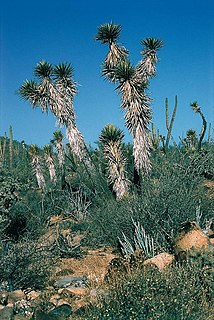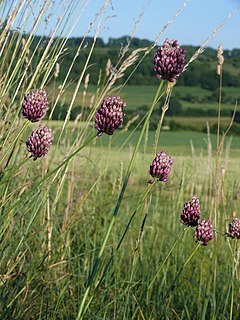
Cupressus arizonica, the Arizona cypress, is a North American species of tree in the cypress family Cupressaceae, native to the southwestern United States and Mexico. Populations may be scattered rather than in large, dense stands.

Paeonia californica is a perennial herbaceous plant of 35–70 cm high, that retreats underground in summer, and reoccurs with the arrival of the winter rains. It has lobed leaves, elliptic (cup-shaped) drooping flowers with dark maroon-colored petals, and many yellow anthers. It flowers mostly from January to March, and later develops two to five fruits per flower. Its common name is California peony and it is sometimes also referred to as wild peony. This peony is an endemic of southwestern California (USA), where it is not rare, and northernmost Baja California (Mexico). It grows on dry hillsides in the coastal sage scrub and chaparral communities of the coastal mountains of Southern and Central California, often as an understory plant.

Allium unifolium, the one-leaf onion or American garlic, is a North American species of wild onion. It is native to the coastal mountain ranges of California, Oregon, and Baja California. It grows on clay soils including serpentine, at elevations up to 1100 m.

Coreopsis maritima, the sea dahlia, is a species of tickseed in the sunflower family.
Wislizenia refracta, common names jackass-clover or spectacle fruit, is one of the three recognized species in its genus Wislizenia, although some authors have suggested considering them as subspecies. Wislizenia refracta is native to northwestern Mexico and the southwestern United States. It has been reported from Chihuahua, Sonora, trans-Pecos Texas, New Mexico, Arizona, Utah, Nevada and from California. The species occurs in sandy flats, in desert scrub, and on disturbed sites such as roadsides.

Ericameria cuneata is a species of flowering shrub in the daisy family known by the common name cliff goldenbush. This plant is native to the southwestern United States and northwestern Mexico.

Allium praecox is a species of wild onion known by the common name early onion.

Ambrosia pumila is a rare species of herbaceous perennial plant known by the common names San Diego ragweed and San Diego ambrosia. It is native to far southern California, Baja California, and Baja California Sur. It grows in floodplains and open grasslands in proximity to wetland areas.

Baccharis brachyphylla is a North American species of shrub in the daisy family, known by the common name shortleaf baccharis or false willow. It is native to the southwestern United States and northern Mexico. It grows in desert habitats such as arroyos and canyons.
Baileya pauciradiata is a North American species of flowering plant in the daisy family which is known by the common names laxflower and Colorado desert marigold. It is native to the deserts of northwestern Mexico and the Southwestern United States. It has been found in the States of California, Arizona, Nevada, Baja California, and Sonora.

Yucca valida is a plant species in the family Asparagaceae, native to the Mexican states of Baja California, Baja California Sur, Sonora, and Sinaloa. The common name is datilillo.

Celtis ehrenbergiana, called the desert hackberry or spiny hackberry, is a plant species that has long been called C. pallida by many authors, including in the "Flora of North America" database. It is native to Arizona, Florida, New Mexico and Texas, and to Latin America as far south as central Argentina. It grows in dry locations such as deserts, brushlands, canyons, mesas and grasslands.

Ambrosia salsola, commonly called cheesebush, winged ragweed, burrobush, white burrobrush, and desert pearl, is a species of perennial shrub in the sunflower family native to deserts of the southwestern United States and northwestern Mexico.
Calyptridium pygmaeum, synonym Cistanthe pygmaea, common name pygmy pussypaws, is a plant species endemic to California. It has been reported from Riverside, San Bernardino, Inyo, Tulare and Fresno Counties, in pine and subalpine forests at elevations of 1900–3550 m.
Ceanothus otayensis, the Otay Mountain buckbrush or Otay Mountain lilac, is a plant species known only from the Otay and San Miguel Mountains of San Diego County, California, and in nearby Baja California, Mexico. It occurs on dry slopes and brushlands at elevations of 600–1100 m.

Arctostaphylos hooveri, the Santa Lucia manzanita, is a plant species endemic to the Santa Lucia Mountains in Monterey County, California. It grows in woodlands and in chaparral scrub-land at elevations of 900–1200 m.
Lipocarpha occidentalis, the Western halfchaff sedge, or Pacific halfchaff sedge, is a plant species native to western part of the United States but cultivated as an ornamental in other regions. It is widespread in California, with populations also reported from Oregon and Washington state.

Allium macropetalum, the desert onion, is a species of wild onion native to the desert regions of southwestern United States and northwestern Mexico. It is known from desert plains and hills in Sonora, Arizona, Utah, Colorado, New Mexico, and Texas, at elevations up to 2500 m.

Allium rotundum, common name round-headed leek or purple-flowered garlic, is a Eurasian and North African species of wild onion. Its native range extends from Spain and Morocco to Iran and European Russia. It is sparingly naturalized in parts of the United States. The species grows in disturbed habitats such as roadsides, cultivated fields, etc.
Ericameria parishii is a western North American species of flowering plants in the daisy family.














